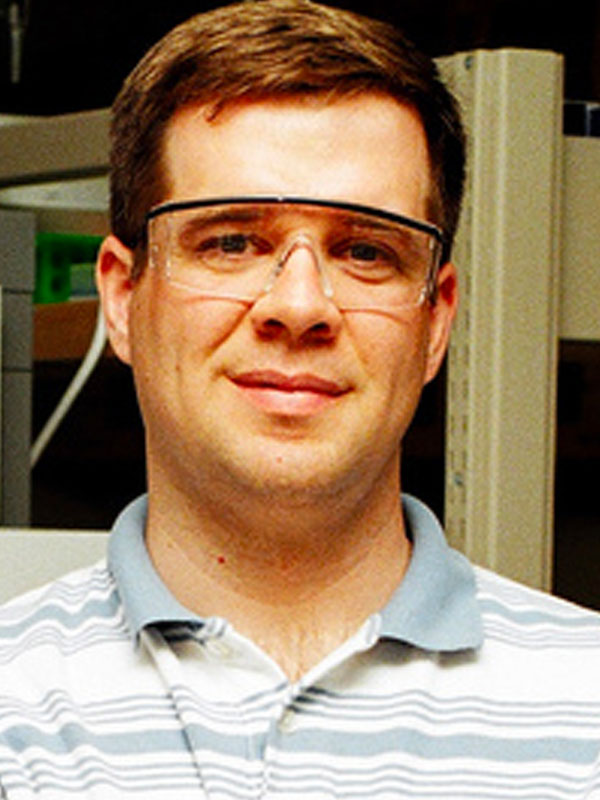Academic Degrees
- Ph.D., Virginia Tech, 1996
- B.S., Purdue University, 1991
Experience
Projects:
- Characterization of recombinant and human plasma glycoprteins
Areas of Research and Professional Interest
- Functional Protemics
- Design and production of "unnatural proteins"
- Non-linear optical (NLO) materials
Research Profiles:
Courses Taught
- CHME 114 - Introduction to Chemical Engineering II
- CHME 333 - Transport Operations II
- CHME 473/873 - Biochemical Engineering
- CHME 474/874 - Advanced Biochemical Engineering
About Kevin Van Cott
My lab is focused on high-level molecular characterization of therapeutic proteins. We use a variety of analytical methods to do this, specializing in HPLC (RP-HPLC, IEX-HPLC, NP-HPLC, and SEC-HPLC) and mass spectrometry methods. We also develop and perform many the traditional analytical biochemical methods as well (simple enzyme kinetics assays, blood coagulation assays, ELISAs, SDS-PAGE, western blot, etc.).
High-level characterization of recombinant proteins is becoming increasingly important as technology improves and regulatory agencies require a better understanding of new drug products. It is becoming clear that characterization needs to begin early in product development – starting with cell line development and clone selection. With new opportunities in Biosimilars, the FDA is placing even more weight on good characterization data. Unfortunately we have seen several cases where products have failed after millions of dollars were spent, simply because characterization was ignored in the early stages.
Our group has significant experience in the characterization of glycoproteins using HPLC and MS methods. We also develop comprehensive peptide maps for therapeutic proteins that can be used as the basis of release assays or for characterization information. Our approach is not the typical “run the data through Mascot and email you the Mascot link” approach one often gets from centralized labs and core facilities. We treat each protein uniquely, and strive to attain all the objectives that are needed to fully characterize the protein. Multiple enzyme digests will be used to maximize sequence coverage, and we can also include top-down and middle-up LC-MS approaches. We have experience in characterizing the following post-translational modifications:
- N-glycosylation
- O-glycosylation
- sulfation
- phosphorylation
- disulfide bond mapping
- hydroxylation
- deamidation
- acetylation
- oxidation
- gamma-carboxylation
- N-terminal propeptide proteolysis
We have also helped clients identify other problems in their products – such as internal proteolysis, mistranslation, and the presence of splicing variants. We will adjust our methods to focus on specific PTMs if necessary: using different proteases, adjusting the chromatographic conditions, and using MS detection methods such as precursor ion scans, neutral loss scans, or MRM as the situation dictates.
The purity of protein products is important, especially for therapeutics that are given at large doses (e.g., monoclonal antibodies), or over a long period of time (e.g., proteins that treat a genetic deficiency). Traditional methods for detecting and quantifying host cell proteins (HCPs) include immunological methods such as ELISAs. These methods have several shortcomings and are gradually being replaced by more powerful LC-MS methods. We have worked on the identification of HCPs in products derived from E. coli, yeast, and mammalian cells. We can use traditional proteomics methods to identify as many HCPs as possible in a sample (drug substance, intermediate sample from early in the purification), and then we develop targeted LC-MRM methods to quantitate specific host cell proteins in the sample. This quantitation can be on a relative basis (e.g., with respect to the Product Protein), or on an absolute basis (e.g., fmol HCP/microliter).
We are not the traditional academic research lab in that we work primarily with private companies and federal labs/agencies. The products we have characterized in the last 6 years include the following:
- Six recombinant vaccine proteins for national defense applications (yeast and E. coli expression)
- Recombinant cardiovascular therapeutic (yeast expression)
- Recombinant anti-cancer fusion protein (receptor binding domain + toxin, E. coli expression)
- Three recombinant coagulation glycoproteins (mammalian expression)
- Two recombinant coagulation glycoproteins (mammalian expression)
- Recombinant vaccine protein (E. coli expression)
- Recombinant monoclonal antibody (mammalian expression)
During the execution of these projects we have performed the following tasks:
- Comparability studies of drug substance vs. drug product
- Comparability studies of drug product and stability study samples
- Comparability studies for both upstream and downstream process changes
- PTM analysis to support column fraction pooling decisions
- PTM analysis to support clone selection decisions
- Disulfide mapping to support higher order structure requirements
- Discovery, identification, and quantitation of mistranslation events due to unoptimized codon choice
- O-glycopeptide mapping
- Discovery of a new O-glycosylation site
- Quantitation of a splice-variant
- Confirmation and quantitation of phosphorylation and sulfation
- Identification and quantitation of host-cell proteins (HCPs)
- Analysis of product stability during harvesting and downstream purification
- N-glycan characterization to provide correlation of glycan properties with pharmacokinetic behavior in animal models.
- Peptide mapping and glycan characterizaiton to support IND and BLA submissions
Selected Publications
- Meagher MM, Seravalli JG, Swanson ST, Ladd RG, Khasa YP, Inan M, Harner JC, Johnson SK, Van Cott K, Lindsey C, Wannemacher R, Smith LA. (2011) Process development and cGMP manufacturing of a recombinant ricin vaccine: An effective and stable recombinant ricin a-chain vaccine-RVEc™. Biotechnol Prog. 27(4):1036-1047.
- Gil GC, Iliff B, Cerny R, Velander WH, Van Cott KE. (2010) High throughput quantification of N-glycans using one-pot sialic acid modification and matrix assisted laser desorption ionization time-of-flight mass spectrometry. Anal Chem. 82(15):6613-6620.
- Gil G, Velander WH, Van Cott KE. (2009) N-glycosylation microheterogeneity and site occupancy of an Asn-X-Cys sequon in plasma-derived and recombinant Protein C. Proteomics. 9(9): 2555-2567.
- Gil G, Velander WH, Van Cott KE. (2008) Analysis of the N-glycans of Recombinant Human Factor IX Purified from Transgenic Pig Milk. Glycobiology, 18(7):526-539.

